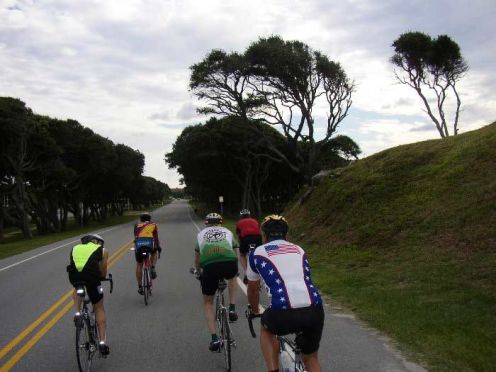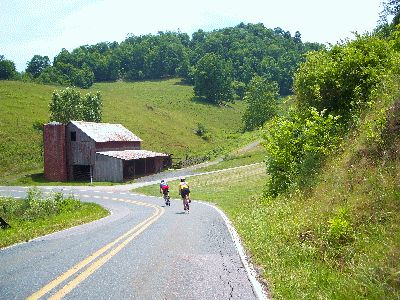Beginning Competitive Cycling- Keys To The Kingdom
Getting into shape-the very beginning!
The absolute best thing to do starting out is to take an audit of your physical condition. You should have a physical exam to determine if there are any hidden health issues as you increase the intensity of exercise. This is particularly true if you’re over forty or have a history of medical problems, especially if there is a history of heart problems in the family tree.
Next in the fitness audit is to determine your endurance quotient or Anaerobic Threshold (AT). The AT is the body’s breaking point. This is when you “run out of gas”. The less fit you are, the lower your AT is. You will improve by gradually increasing your AT until you go further and faster until you “hit the wall”.
Your AT is related to your pulse rate. Subtract your age from 220 to get your maximum recommended pulse rate during exercise.

Determining Your Pulse
The pulse can be calculated quickly:
1) Place your index and middle finger over your heart, on your wrist artery, or on your neck artery.
2) Count the number of beats during a ten second period using a stopwatch or second hand on a watch or clock.
3) Multiply this number of beats by 6. This gives you your current pulse rate.

Minimum And Maximum
The minimum and maximum thresholds to safely build endurance while not exceeding your AT is between 65% and 85% of your maximum heart-rate (AT).

Thresholds
EXERCISE THRESHOLDS BY PULSE RATE
(BEATS PER MINUTE- 65% TO 85 % OF MAXIMUM
Minimum Threshold Minimum Threshold
Age Group (65% of Maximum) (85% of Maximum)
16-20 133 170
21-25 129 166
26-30 126 162
31-35 123 157
36-40 120 153
41-45 116 149
46-50 113 145
51-55 110 140
56-60 107 136
61-65 103 132
66-70 100 128
71-75 97 123

Oxygen Debt
Listen to your body. It will tell you if you’re “going too hard”. It’s fine to be in moderate pain and breathing deeply, huffing and puffing. Back off if you grow weak or your breathing becomes labored or painful. Feeling rubber-legged and gasping for air is a result of pushing too hard. This means that you’ve crossed your Anaerobic Threshold. You are going from aerobic to anaerobic. You are no longer processing oxygen sufficiently to allow the muscles to function efficiently. You are creating an oxygen debt. Muscles, lungs, heart, and finally the brain will not work very long in an anaerobic state. This is when the body’s ability to process sufficient oxygen is overcome by the production of lactic acid by the straining muscles.
The body is say you should “back off” a bit. The fitter you are the quicker you will be able to recover and repay this oxygen debt.

For the former sedentary person, 5 to 10 miles every other day at a pace to keep the pulse rate at least at 65% of maximum, for the duration of the ride, will bring noticeable improvement within a month.
For the athletic person, runner say, it would be very easy to start out at 10 miles or more, immediately.
As you get into a cycling exercise program, muscle tissue builds up and fat tissue burns off. There may be a “redistribution” of weight instead of a weight loss, immediately. When you can consistently handle hard 2 hour rides, weight will really start to come off.
Eat fuel, not fat. See Food For Fueling!
Give it time. Losing weight through regular, strenuous exercise, with good nutrition may take longer than a crash diet but the end results will be better.

Taking the work-outs more seriously does not mean quitting your job or giving up your family. A respectable fitness can be attained through one to two hours of cycling per day.
I can stay in good condition with 32 minutes of workout on most days with concentration on diet. A day or two per week I can ride with groups or push the intensity for harder workout days. It does little good to go out and push hard gears all the time. Pushing hard constantly will build bad form and slow your recovery to train another day.

Tempo And Intervals
Focus on 90 crank revolutions per minute. This is the best exercise to practice. This is what your legs need to be doing, even in race conditions.
For basic conditioning training, you could, alternate your days with “tempo riding” and intervals.
A 20 mile tempo ride could be two miles of warm-up focusing on 90 rpm, 17 miles at your threshold pace, and a mile cool-down at 90 rpm.
A good one hour work-out with interval training could be 15 minute warm-up with low gears at 90 rpm. Thirty minutes of intervals could include two minutes of hard work-out at 75% to 80% maximum pulse rate, six minutes rest with a low gear and 90 rpm, and repeat the sequence four times. Lastly, cool down with a low gear at 90 rpm.
It’s best to do the intervals on flat ground but the same can be achieved by attacking small hills of a half mile or three quarters of a mile (or so) every six or seven minutes during the interval portion of the work-out.
These are work-outs for the two to three month “break-in” period. This will be a great foundation to “spring” into other specific cycling challenges.

Focus
1) Vary tempo days with interval days. Steady speed work-outs alternating with days of interval sessions are the best for building stamina.
2) Always train at between 65% and 80% of maximum pulse rate. Lower than this is not real exercise; higher can be dangerous.
3) Pedal at a cadence between 85 and 90 rpm. This has been proven to be the most efficient rate.
4) Maintain a nutritious diet. A high performance car needs high octane fuel.
5) Take longer rides on week-ends. Group rides will help you chart your progress.

A Typical Week
Monday- Take a day off. This could be the day.
Tuesday- One hour tempo ride
Wednesday- One hour long intervals
Thursday- One hour tempo ride
Friday- One hour long intervals
Saturday- Two hour group ride
Sunday- Two to three hour group ride

Food For Thought
These can surely be suggestions as your work-week can vary as well as your age.
My week, at 60 years of age with about 40 years of cycling behind me, can be just a matter of maintenance during the week with the harder work-outs on the week-ends. This can be in winter or summer. Quite often I’m trying to recover during the week after going hard on the week-end.
My main thoughts go into riding 32 minutes every day and maintaining a great diet with supplements because we’re doing or wanting to do some extraordinary things with food that has been compromised.
You'll need Food For Fueling!









